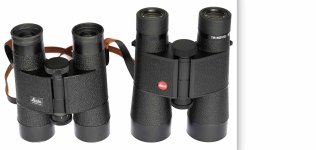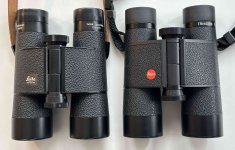John A Roberts
Well-known member

In a 'blast from the past', Roger has added a review of an original Leitz Trinovid 7x35B, dating from the late 1960’s,
see at: Leitz 7x35B Trinovid Review
Original Leitz 7x35B verses current Leica 8x40:

Roger has previously reviewed both the current Leica 'Retrovid' 7x35 and 8x40 models that were introduced in 2019,
see at: Binocular Reviews
And as can be seen, while the new models have the same external body as the original Leitz versions, they differ in various ways including:
• having Schmidt-Pechan rather than Uppendahl prisms;
• the eyepiece designs;
• focusing by moving a lens in the objective, rather than than by moving lenses in the eyepiece, and;
• having much updated lens and prism coatings
(and though lacking a B designation, all three current models have long eye relief eyepieces).
In terms of the chronology of the original Leitz models:
• the first models in 6x24, 8x32 and 10x40, were introduced in 1963;
• the first long eye relief model the 7x35B, was introduced in 1965;
• with the 7x42B following in 1968, and the 8x40B in 1969, and;
• the updated 8x32B and 10x40B versions, were introduced in 1974 (there was no 6x24B).
RA versions were introduced in 1979, and production finally ended in 1988 (the all new Leica BA series was introduced in 1990).
For more on the history of the Leitz models, see various posts at: https://www.birdforum.net/threads/leitz’s-trinovids-models-and-numbering.370117/
Much is summarised in post #56 - but be aware of Gary’s caution in post #45, in assuming too strict a chronology in terms of the serial numbering.
. . . So, Roger’s Leitz 7x35B #724,537 with the original propriety strap lugs, would date from the late 1960’s
(loops for a standard 10 mm strap end were introduced around 1971).
John
see at: Leitz 7x35B Trinovid Review
Original Leitz 7x35B verses current Leica 8x40:

Roger has previously reviewed both the current Leica 'Retrovid' 7x35 and 8x40 models that were introduced in 2019,
see at: Binocular Reviews
And as can be seen, while the new models have the same external body as the original Leitz versions, they differ in various ways including:
• having Schmidt-Pechan rather than Uppendahl prisms;
• the eyepiece designs;
• focusing by moving a lens in the objective, rather than than by moving lenses in the eyepiece, and;
• having much updated lens and prism coatings
(and though lacking a B designation, all three current models have long eye relief eyepieces).
In terms of the chronology of the original Leitz models:
• the first models in 6x24, 8x32 and 10x40, were introduced in 1963;
• the first long eye relief model the 7x35B, was introduced in 1965;
• with the 7x42B following in 1968, and the 8x40B in 1969, and;
• the updated 8x32B and 10x40B versions, were introduced in 1974 (there was no 6x24B).
RA versions were introduced in 1979, and production finally ended in 1988 (the all new Leica BA series was introduced in 1990).
For more on the history of the Leitz models, see various posts at: https://www.birdforum.net/threads/leitz’s-trinovids-models-and-numbering.370117/
Much is summarised in post #56 - but be aware of Gary’s caution in post #45, in assuming too strict a chronology in terms of the serial numbering.
. . . So, Roger’s Leitz 7x35B #724,537 with the original propriety strap lugs, would date from the late 1960’s
(loops for a standard 10 mm strap end were introduced around 1971).
John
Last edited:






